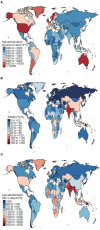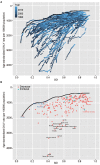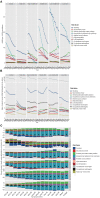Global, regional, and national burden of chronic respiratory diseases and associated risk factors, 1990-2019: Results from the Global Burden of Disease Study 2019
- PMID: 37056726
- PMCID: PMC10088372
- DOI: 10.3389/fmed.2023.1066804
Global, regional, and national burden of chronic respiratory diseases and associated risk factors, 1990-2019: Results from the Global Burden of Disease Study 2019
Abstract
Background: The burden of chronic respiratory diseases has changed over the three decades. This study aims to describe the spatiotemporal trends of prevalence, mortality, and disability-adjusted life years (DALY) due to chronic respiratory diseases (CRDs) worldwide during 1990-2019 using data from the Global Burden of Disease Study 2019 (GBD 2019).
Methods: The prevalence, mortality, and DALY attributable to CRDs and risk factors from 1990 to 2019 were estimated. We also assessed the driving factors and potentiality for improvement with decomposition and frontier analyses, respectively.
Results: In 2019, 454.56 [95% uncertainty interval (UI): 417.35-499.14] million individuals worldwide had a CRD, showing a 39·8% increase compared with 1990. Deaths due to CRDs were 3.97 (95%UI: 3.58-4.30) million, and DALY in 2019 was 103.53 (95%UI: 94.79-112.27) million. Declines by average annual percent change (AAPC) were observed in age-standardized prevalence rates (ASPR) (0.64% decrease), age-standardized mortality rates (ASMR) (1.92%), and age-standardized DALY rates (ASDR) (1.72%) globally and in 5 socio-demographic index (SDI) regions. Decomposition analyses represented that the increase in overall CRDs DALY was driven by aging and population growth. However, chronic obstructive pulmonary disease (COPD) was the leading driver of increased DALY worldwide. Frontier analyses witnessed significant improvement opportunities at all levels of the development spectrum. Smoking remained a leading risk factor (RF) for mortality and DALY, although it showed a downward trend. Air pollution, a growing factor especially in relatively low SDI regions, deserves our attention.
Conclusion: Our study clarified that CRDs remain the leading causes of prevalence, mortality, and DALY worldwide, with growth in absolute numbers but declines in several age-standardized estimators since 1990. The estimated contribution of risk factors to mortality and DALY demands the need for urgent measures to improve them.
Systematic review registration: http://ghdx.healthdata.org/gbd-results-tool.
Keywords: Global Burden of Diseases; Injuries; and Risk Factors Study; chronic respiratory diseases; epidemiology; risk factor; sociodemographic index.
Copyright © 2023 Chen, Zhou, Fu, Li, Chen, Zhang and Chen.
Conflict of interest statement
The authors declare that the research was conducted in the absence of any commercial or financial relationships that could be construed as a potential conflict of interest.
Figures




References
Publication types
LinkOut - more resources
Full Text Sources

